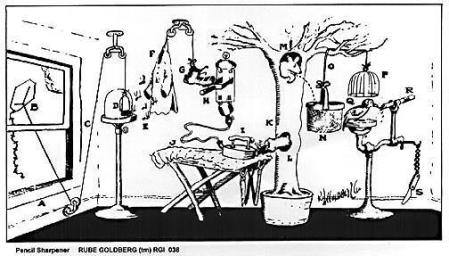My customer’s “tweet” says, “We’d like to know why creativity and concept development have no value in the ad world.” Poor Richard knows what’s behind this one.
We used to call them “take the cake” episodes. When I was a teenager, my friend’s mom used this expression a lot. I can still see Mrs. K, hands on hips, very exasperated with something that her daughter, me or one of our other friends had done. Drawing a deep breath and pushing her eyeglasses up her nose with the back of her right hand, she would exclaim, “Well! doesn’t that just take the cake!” This was followed by a perfect military turn and usually a slammed door as she left us to contemplate the consequences of our misdemeanors.
We had a “take the cake” moment today. Brian, our production manager, received the customer at the door. He had come to inquire about business cards . . . not unusual. Specifically, he had come to inquire about business cards we had already printed for his company. The cards were designed by an agency we work closely with and were produced for them. He wanted to know our price to produce the cards, because he felt he had been charged too much.
We already knew that there was some dissatisfaction with the original run of the cards. His cards had originally been produced them on our house 80# stock and then we’d been asked to run them again on a heavier and nicer stock. Brian, wisely reasoning that it was better for me to get into trouble than him, excused himself and ran for the back where Poor Richard was actually about to cut the second set of cards. Brian briefed me on the situation, but I don’t think I really grasped what the fellow had come for. I grabbed a sheet of the uncut cards and headed for the lobby.
I went to the front counter and introduced myself, handing my customer’s customer the sheet of cards and explaining that they would be ready very shortly. He examined the cards and stated that he didn’t realize they were being reprinted. He objected to the size of a line of type and proceeded to ask again how much the set of cards would cost. He stated an amount that he had been charged by the agency and that he had been purchasing printing and cards for years and thought the amount was excessive.
I explained that while our price to the agency was less than the dollar amount he had stated, it is quite understandable that an agency would charge for the work they do. Our customer, the agency, created the design, did the layout, provided the proofs and handled the details of printing. It should be expected that they would add a charge for their work to the cost of the actual cards. I also tried to assure him that he was working with a talented and capable group and that they had done a great job with his design.
The conversation remained polite, but just went off track at that point. My customer’s customer explained that he had gone to the agency needing a name and logo for a new company, website work, and consultation for search engine optimization. He had ended up with a name, a logo, business cards and other such stuff; when all he had really needed was the website work. In fact, he had created the website himself for $50 and had received a lot of compliments. He fished a few times more for the price of the cards. He didn’t say it outright, but it was evident that he felt he had been taken for a ride.
I tried, but I don’t think that I was successful at dealing with the real problem. The problem was not the price of the cards, but their perceived and actual value. Our customer’s customer perceived some value in the cards he had received, but little in the work that went into them. Even though he was unable to create the name and do the layout, he didn’t assign any value to those services. I’ll also guess that it took a little time on the part of the agency to get him to come to a decision. He didn’t assign any value to that time, either.
Poor Richard has a lot of respect for the agency in question. They are a good customer of AlphaGraphics and also friends of mine. They understand marketing and the current trends. They are practical folks. They know what works. I think they understand the budget constraints of small business. And they are very creative, very patient, very kind people. Their creativity, expertise and their patience all have value and they rightly charge for it. If I had to bet, it would be that their customer received much more in value than he actually paid for.
There is a move afoot to convince printers that we should become “marketing service providers.” This sounds good at first, because content is moving online and the volume of print is dropping dramatically. That means that many of us are no longer making money. We need something to hang our hats and our hopes on. But we also need to define what the new phrase really means.
Poor Richard has written before on the difficulties of trying to integrate creative design into a production environment (see The Trouble With Printshop Design). If being a marketing service provider means taking on customers like this one, printers will fail miserably and many will go ballistic in the process. Most of us are production people at the core. We like machines, gadgets, and ways of getting things done. The value we create now is mostly in tangible products. It is conceivable that we could get involved in handling customer data and doing the implementation of some aspects of a marketing program, but printers in general are not good at conceptual work. Most of us don’t like it and we don’t have time for it.
I empathize with the exasperation my customer expressed in the Twitter post cited above. Most people don’t do well with ideas. Very few people think them through carefully before implementing them. Even fewer measure their effect after implementation, then correct and try again. These are the things that a good creative agency does well, if their customers will let them. There is great value in this capability and it can be measured by the return that their clients reap as the result of a well conducted marketing campaign.
I guess it’s necessary to explain and re-explain the value proposal. Value is created when a vendor provides something for a customer that the customer cannot do or does not want to do himself (or cannot do correctly or efficiently by himself). The customer chooses to pay the provider for the value of the service or product. In this case, the customer got confused. He thought that he was buying a product (business cards) and didn’t assign a value to the conceptual and design work necessary to create them.
 It’s not that the concept and the product aren’t related. Concept and product aren’t apples and oranges. I guess they’re oranges and lemons, but one has to precede the other. My customer’s customer perceived his agency as a a project shop. He thought he was buying the orange and assigned no value to the lemons that were a necessary part of the package. Poor Richard is sure that my customer’s customer received good ideas and practical suggestions from the agency he chose. He suspects that much (if not all) of that proposal was ignored and that the agency ended up developing “stuff” rather than engineering a marketing campaign. And the value the customer assigned to the “stuff” was not equal to the time and energy that was spent developing it.
It’s not that the concept and the product aren’t related. Concept and product aren’t apples and oranges. I guess they’re oranges and lemons, but one has to precede the other. My customer’s customer perceived his agency as a a project shop. He thought he was buying the orange and assigned no value to the lemons that were a necessary part of the package. Poor Richard is sure that my customer’s customer received good ideas and practical suggestions from the agency he chose. He suspects that much (if not all) of that proposal was ignored and that the agency ended up developing “stuff” rather than engineering a marketing campaign. And the value the customer assigned to the “stuff” was not equal to the time and energy that was spent developing it.
I’m very sorry that my customer is exasperated. They don’t deserve to be. Poor Richard was a little exasperated, too. I quit cussing a few years ago, but I thought of Mrs. K. As the gentleman left the shop, I pushed up my glasses with the back of my right hand and exclaimed “Well, doesn’t that just take the cake!” Executing a brisk military turn, I marched off to the back of the shop. If there’d been a door to slam, I would have.





 Posted by poor richard
Posted by poor richard 


 So maybe I’ve crossed the line. I never intended this blog to belittle or to be demeaning and certainly not to frighten off a customer who might consider coming into our printshop. The phone call I received from the franchise just a little over a week ago led me to believe that I may have done all three. It was from the new marketing director, a person I had never encountered before. She began by asking questions about the blog . . . what was it’s purpose?
So maybe I’ve crossed the line. I never intended this blog to belittle or to be demeaning and certainly not to frighten off a customer who might consider coming into our printshop. The phone call I received from the franchise just a little over a week ago led me to believe that I may have done all three. It was from the new marketing director, a person I had never encountered before. She began by asking questions about the blog . . . what was it’s purpose? It’s not that the concept and the product aren’t related. Concept and product aren’t apples and oranges. I guess they’re oranges and lemons, but one has to precede the other. My customer’s customer perceived his agency as a a project shop. He thought he was buying the orange and assigned no value to the lemons that were a necessary part of the package. Poor Richard is sure that my customer’s customer received good ideas and practical suggestions from the agency he chose. He suspects that much (if not all) of that proposal was ignored and that the agency ended up developing “stuff” rather than engineering a marketing campaign. And the value the customer assigned to the “stuff” was not equal to the time and energy that was spent developing it.
It’s not that the concept and the product aren’t related. Concept and product aren’t apples and oranges. I guess they’re oranges and lemons, but one has to precede the other. My customer’s customer perceived his agency as a a project shop. He thought he was buying the orange and assigned no value to the lemons that were a necessary part of the package. Poor Richard is sure that my customer’s customer received good ideas and practical suggestions from the agency he chose. He suspects that much (if not all) of that proposal was ignored and that the agency ended up developing “stuff” rather than engineering a marketing campaign. And the value the customer assigned to the “stuff” was not equal to the time and energy that was spent developing it.